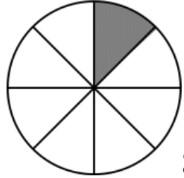What are fractions?
Topic Notes
In this lesson, we will learn:
- How to understand and write fractions using shape models
- How to understand and write fractions using groups of objects
- How to show fractions on number lines
Notes:
- Fractions are parts of a whole!
- Fractions represent smaller pieces of a total (whole) thing
- Whole shapes are divided into equal parts
- Whole groups are divided into equal smaller groups (number of items)
- If you have number of equal parts of a shape, then each part is worth of a whole.
- Ex.
 8 equal parts; each part is of a whole
8 equal parts; each part is of a whole - When writing a fraction with numbers, there are two parts:
- The top (the “numerator”) represents how many parts you have
- The bottom (the “denominator”) represents how many total parts the whole is divided into
- Ex.

- Fractions can also represent groups of objects.
- Ex. what fraction of these jellybeans are green?
- If you were to count:
- all the jellybeans it would be: jellybeans
- the jellybeans that were NOT green: not green
- the jellybeans that ARE green and NOT green: jellybeans
- if you add all the different parts of the whole, you will end up with the whole (when the top is equal to the bottom)


